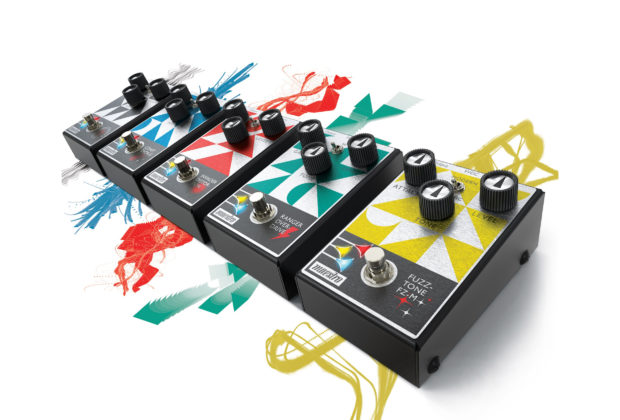Gibson’s Maestro brand has a history of sonic firsts going back to the late 1950’s and 1960’s. Back then, Maestro was ahead of the curve with the Maestro BG-1 Boomerang Wah, Echoplex and the FZ-1 Fuzz pedal, the world’s first mass produced guitar effects pedal. The FZ-1 Fuzz was first introduced by Gibson when recording engineer Glenn Snoddy took his original design to Maurice Berlin, who was then president of Gibson CMI (Chicago Musical Instruments). Berlin gave the go-ahead to incorporate the effect into a stand-alone effect pedal.
The initial FZ-1 Fuzz was not a big seller, but that abruptly changed when Keith Richards used a FZ-1 Fuzz pedal while recording “(I Can’t Get No) Satisfaction,” after which Gibson promptly sold 40,000 units. Re-released briefly in the ‘90s as the FZ-1A Fuzz Tone, the Gibson fuzz effect pedal was shelved until the Fuzz Tone FZ-M was released under the revived Maestro brand earlier this year as part of the Maestro Original Collection of guitar effect pedals. All effects in the Maestro Original Collection are vintage inspired, and feature classic analog designs enhanced with modern features.
The Maestro Original Collection consists of the Fuzz-Tone FZ-M, Invader Distortion, Ranger Overdrive, Comet Chorus and Discoverer Delay. Unboxing any of the pedals shows the control layout on all five pedals is the same. All the controls are top mounted with true bypass switching and housed in angled road worthy steel enclosures. All five pedals in the Maestro Original Collection have three knobs and one toggle switch to dial in additional effect parameters specific to each pedal. The LED backlit logo is the original Maestro brand design from the 1960s. The Fuzz-Tone FZ-M, Invader Distortion, and Ranger Overdrive feature the same three basic controls: Gain (attack on the Fuzz-Tone FZ-M), Level, and Tone. The Comet Chorus has three knobs to control Depth, Mix, and Speed, and the Discoverer Delay’s three knobs control Delay, Mix, and Sustain.
The Fuzz-Tone FZ-M is a modern update to the vintage FZ-1, the world’s very first commercially successful guitar effect pedal. The Fuzz-Tone FZ-M features two switchable modes—Classic and Modern—Classic mode provides a voicing inspired by the original FZ-1, while Modern mode provides a fuller, more modern Fuzz.
The Attack control determines the amount of Fuzz and clipping while the Tone control functions as a traditional high pass or low pass filter, depending on what position the mode switch is in. The Level control determines the overall output of the pedal. The Fuzz-Tone FZ-M will typically work best in front of your signal path, meaning in front of your amp’s input, or as the first pedal of your signal chain on your pedal board.
The Invader Distortion is a modern distortion pedal and features a switchable gate, a relatively unique feature not typically found on a standalone guitar distortion pedal. The pedal’s three knobs control the overall Gain, Tone, and Level of the effect. There is an internal trim control inside the pedal that lets you adjust the desired threshold level for the gate. The Invader Distortion pedal’s Gate effect makes it a particularly useful tool for recording guitar parts.
The Ranger Overdrive lets you easily dial in vintage, overdriven distortion tones mixed in with a hint of compression and your clean signal, depending on the position of the mode switch. The up position of the toggle switch gives you more gain and compression with a slight boost in midrange presence; the down position mixes in the effect with some of your summed clean signal, making it an ideal “always on” pedal option.
The Comet Chorus is a classic two mode bucket brigade chorus effect. There are Depth and Speed controls that let you dial in the basic chorus effect and Mix, which determines the overall amount of dry or wet chorus in the effects’ overall output. The mode switch selects from Orbit and Earth modes. Orbit mode gives you a rotary speaker or vibrato-like effect; Earth mode is a more traditional chorus effect. The internal trim pot allows you to fine-tune how much of the traditional rotary speaker effect is blended into the Orbit mode. Pair the Comet Chorus with the Invader Distortion effect pedal for classic, overdriven Leslie tones.
The Discoverer Delay pedal lets you easily dial in delay effects that range from room reverb type ambiance to warm echoes via the Delay, Mix, and Sustain controls. The mode switch kicks in some modulation, the amount of which can be fine-tuned via two internal trim pots that adjust the Rate (speed) and Width (sweep) of the overall delay effect. The Discoverer Delay pedal is great for creating ambient tones and makes a great sonic bed for adding other effects on top of it.
To sum it up, the five pedals in the Maestro Original Collection feature simple, uncomplicated designs enhanced with some highly usable modern features. Whether you are using one or all the pedals in front of your amp, in your amp’s effect loop, or as a recoding effect, the Maestro Original Collection makes dialing in classic tones or your own original sonic creations easy.
Prices for all the pedals in the Maestro Original Collection are $149 MAP except the Discoverer Delay, which is $159 MAP.
Find out more at maestroelectronics.com













